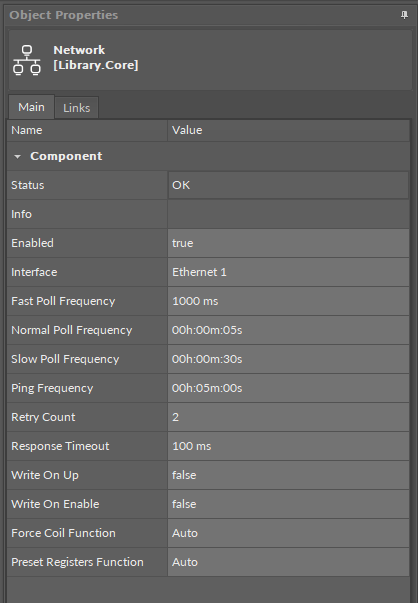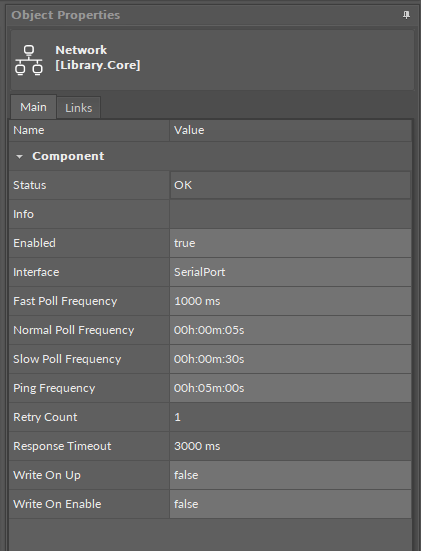Network
Applicable to OS V1.7
The Network component allows to configure the BACnet (IP or MS/TP) or Modbus (TCP/IP or RTU) client network. It allows to add remote devices (using the Device component) and configure basic polling schedule for such devices and their points.

The Network component for Modbus

The Network component for BACnet
The Network component has the following slots:
Status: indicates the current status of the component. If the component works, its status is OK; the component's status becomes Disabled if its Enabled slot has been set to false.
Available information: Disabled, OK.
Info: provides a detailed information about the Disabled and Fault statuses of the component;
Available information:
Could not find selected Port (status Fault): occurs, for example, when the interface set for the network gets deleted;
Incorrect placement - must be placed under a network protocol (status Fault): occurs, when the Network component is placed in a different location than under the BACnet/Modbus component in the Networks container;
Could not find Interfaces container (status Fault): occurs if the Interfaces folder gets manually removed;
Network disabled (status Disabled): the Enabled slot in the Network component is set to false;
Interface disabled (status Disabled): the Enabled slot in the interface component (IpPort/SerialPort), assigned to the network, is set to false;
Enabled: change of the slot's value enables or disables the component;
Available settings: true (enabled), false (disabled);
Note: If the Enabled slot is in false (meaning the component is disabled), the Status slot becomes Disabled.
Interface: allows to set the Ethernet interface for BACnet IP or Modbus TCP/IP client network and the Serial port for BACnet MS/TP or Modbus RTU;
Fast Poll Frequency: sets the time between requests for the point’s value sent in the fast mode;
Normal Poll Frequency: sets the time between requests for the point’s value sent in the normal mode;
Slow Poll Frequency: sets the time between requests for the point’s value sent in the slow mode;
Ping Frequency: sets the time between testing requests to check the device’s connection.
Retry Count: shows a number of repeated requests;
Response Timeout: time set to wait for the device's response;
Write On Up: allows to send all network points values to points in server devices on the network when the devices go from the Down status to OK;
Write On Enable: allows to send all network points values to points in server devices on the network when the devices go from Disabled to Enabled.
Note
The Write On Up and Write on Enable functions are applicable to the following points on BACnet and Modbus networks:
BACnet:
AnalogPoint,
BinaryPoint,
MultistatePoint;
Modbus:
AnalogPoint,
BinaryPoint,
MultistatePoint,
StringPoint.
Slots applicable only for Modbus network:
Force Coil Function: allows to specify whether to force Modbus function 15 for all coil write operations on the device or use network settings;
Preset Register Function: allows to specify whether to force Modbus function 16 for all register write operations on the device or use network settings.
Worth to Notice
In order for the network to be enabled, the Ethernet component (for BACnet IP, Modbus TCP/IP) or the Serial component (for BACnet MS/TP, Modbus RTU), configured for the port defined in the Adapter slot, has to be enabled too.
